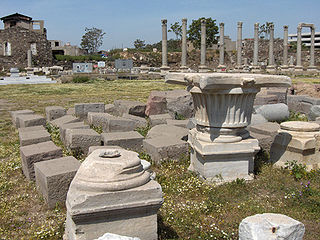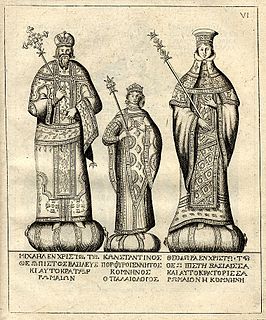Constantine Doukas Nestongos (Greek : Κωνσταντῖνος ∆ούκας Νεστόγγος, fl. 1280–1307) was a Byzantine aristocrat and courtier.

Greek is an independent branch of the Indo-European family of languages, native to Greece, Cyprus and other parts of the Eastern Mediterranean and the Black Sea. It has the longest documented history of any living Indo-European language, spanning more than 3000 years of written records. Its writing system has been the Greek alphabet for the major part of its history; other systems, such as Linear B and the Cypriot syllabary, were used previously. The alphabet arose from the Phoenician script and was in turn the basis of the Latin, Cyrillic, Armenian, Coptic, Gothic, and many other writing systems.
Nestongos first appears in 1280, when he accompanied the co-emperor (and future sole emperor) Andronikos II Palaiologos in his campaign against the Turks in the Maeander River valley. Nestongos at the time held the position of parakoimomenos of the imperial seal. [1] Appointed governor of Nyssa, he held the post until the city fell to the Turks in ca. 1284. [1] Nestongos himself was captured, but had been released by June 1285, when he witnessed a treaty with the Republic of Venice. [1]

Andronikos II Palaiologos, usually Latinized as Andronicus II Palaeologus, reigned as Byzantine Emperor from 1282 to 1328. Andronikos' reign was marked by the beginning of the decline of the Byzantine Empire. During his reign, the Turks conquered most of the Western Anatolian territories of the Empire and, during the last years of his reign, he also had to fight his grandson Andronikos in the First Palaiologan Civil War. The civil war ended in Andronikos II's forced abdication in 1328 after which he retired to a monastery.

Anatolian beyliks, sometimes known as Turkmen beyliks, were small principalities in Anatolia governed by Beys, the first of which were founded at the end of the 11th century. A second more extensive period of foundations took place as a result of the decline of the Seljuq Sultanate of Rûm in the second half of the 13th century.
The parakoimōmenos was a Byzantine court position, usually reserved for eunuchs. The position's proximity to the emperors guaranteed its holders influence and power, and many of them, especially in the 9th and 10th centuries, functioned as the Byzantine Empire's chief ministers.
He is last mentioned in ca. 1307, in a legal dispute between some of his tenants ( paroikoi ) near Smyrna with a local monastery. [1] Some authors identify him with a "Doukas Nestongos" who was megas hetaireiarches in 1304, but this is unlikely since the latter post was much junior in rank to the parakoimomenos. [1]
Paroikoi is the term that replaced "metic" in the Hellenistic and Roman period to designate foreign residents. In Asia Minor they were named katoikoi. In the Byzantine Empire, paroikoi were non-proprietary peasants, hereditary holders of their land, irremovable as long as they paid their rent. They appeared in the Justinian code, which prohibited this status; so it remained provisionally clandestine.

Smyrna was a Greek city dating back to antiquity located at a central and strategic point on the Aegean coast of Anatolia. Since 1930, the modern city located there has been known as İzmir, in Turkey, the Turkish rendering of the same name. Due to its advantageous port conditions, its ease of defense and its good inland connections, Smyrna rose to prominence. Two sites of the ancient city are today within the boundaries of İzmir. The first site, probably founded by indigenous peoples, rose to prominence during the Archaic Period as one of the principal ancient Greek settlements in western Anatolia. The second, whose foundation is associated with Alexander the Great, reached metropolitan proportions during the period of the Roman Empire. Most of the present-day remains of the ancient city date from the Roman era, the majority from after a 2nd-century AD earthquake.




